8 ways to tap the untapped potential of #CultureForHealth
Among other goals, #CultureForHealth points out eight current EU health and wellbeing challenges that have been identified in the existing literature and provides policy recommendations for stakeholders in the cultural, health and social sectors, and decision makers at local, national and European level.
In October 2022, during the Culture and Well-being Forum, also the #CultureForHealth Ideathon took place. The aim of the interactive intervention was to spark specific culture-based solutions to global health and social challenges.
Representatives from the WHO and the EU participated in the ideathon together with politicians, researchers, health professionals, artists, business developers, innovation specialists and many more from 12 European countries and in small working groups reflected on the challenges and the policy recommendations proposed by #CultureForHealth. The group discussions was followed and interpreted by artists from the ArtiViStory Collective.
In this article you can get a short introduction to the challenges addressed by #CultureForHealth and get an glimpse into the ideas sparked at the Ideathon. To see the full review of the challenges and the solutions proposed – check out the #CultureForHealth report.
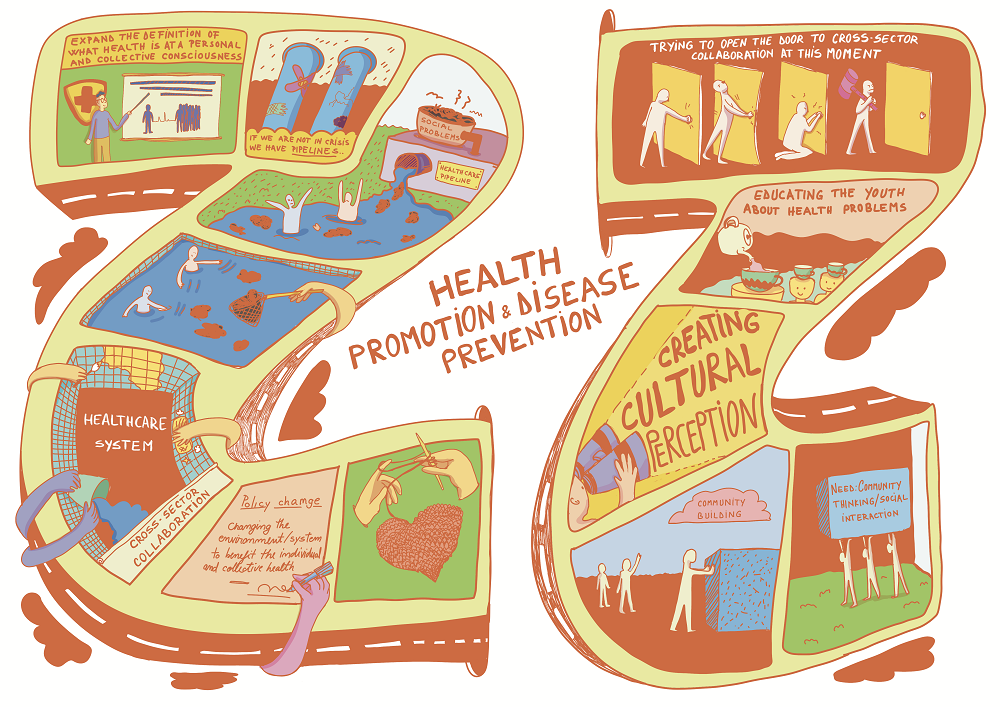
Challenge #1: The need for an increased focus on health promotion and disease prevention
Did you know that in the EU, public and private investments on preventive care was only on average 2.8% of total health expenditure in 2018? Yet scientific knowledge resources: tackling the roots of health issues is highly cost-effective.
The evidence from the scoping review shows that engaging with the arts can help prevent ill health, for instance, through improving respiratory, cardiovascular and cognitive function through singing.
One way how this challenge could be addressed is by recognising the health benefits of culture and thus increasing the spending on mixed-methods approaches based on the combined efforts of health, culture, social care and other budgets. In this context, one could also consider using arts and culture for health communication and increased public engagement during development of health policies.
During ideathon participants emphasized on the need to raise awareness at a personal and collective consciousness that definition of health expands beyond merely absence of disease or infirmity - it is a state of complete physical, mental and social well-being.
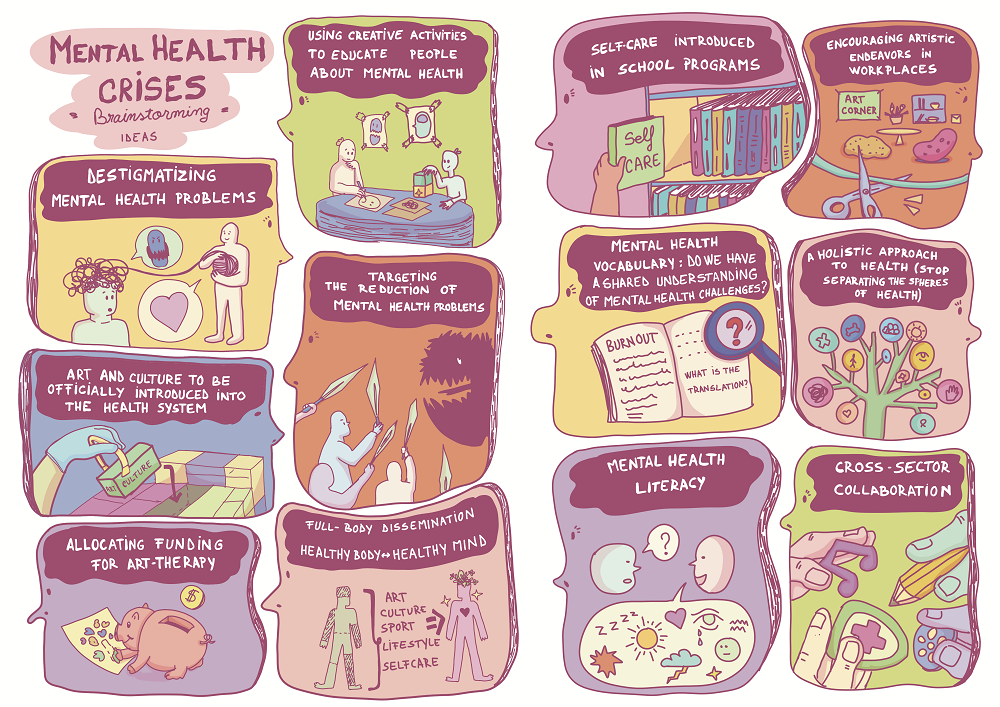
Challenge #2: A growing mental health crisis
We know you've heard this before, but we're going to say it again: mental health is just as important as physical health. More than 85 million citizens in the EU were affected by mental health problems before the COVID-19 pandemic. And while we all know that the pandemic has taken an even harder toll on our mental health, there are other factors at play too—like climate anxiety and war—that are contributing to the mental health crisis.
Studies have shown that active engagement with a variety of creative activities such as singing, dancing, creative writing, drama, visual arts and crafts benefits individuals with mental health problems through reduced anxiety and depression, improved emotion regulation strategies, increased experience of positive emotions, well-being and self-acceptance.
The report suggests that one of the ways this challenge could be addressed is by funding cultural activities with potential benefits in this context by supporting cross-sector partnerships to widen access to these activities, and by enabling further research in the field of culture for mental health and well-being.
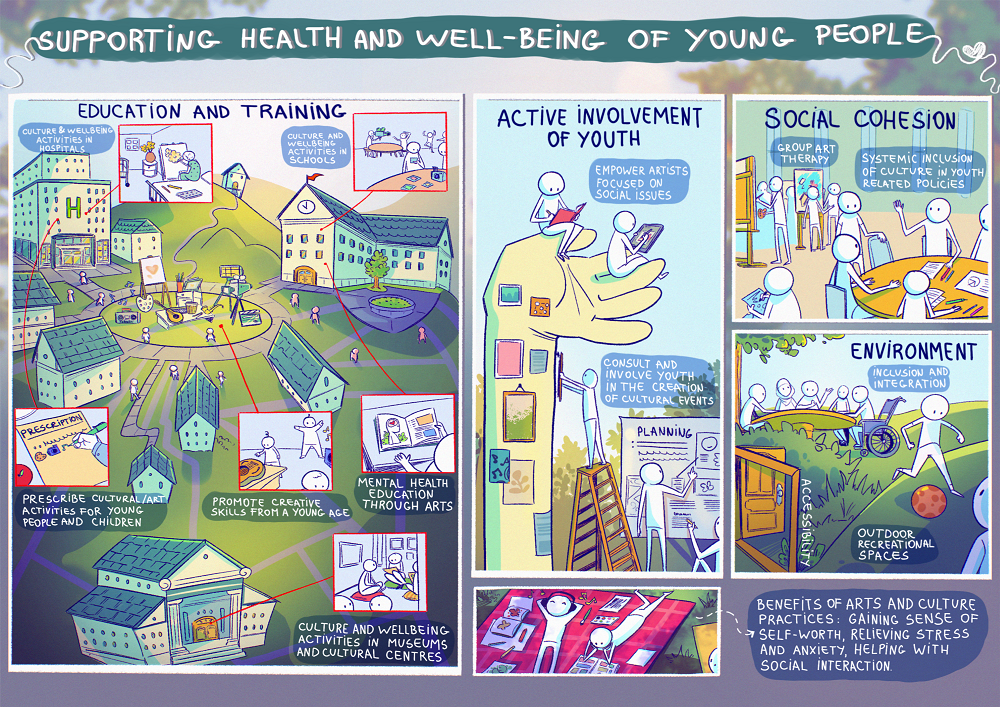
Challenge #3: The need to support the broader health and well-being of young people
Around the world, suicide is the ‘fifth most prevalent cause of death for adolescent boys and girls aged 10–19; for adolescents 15–19, it is the fourth most common cause of death, after road injury, tuberculosis and interpersonal violence’.
Studies has shown that adolescents who actively engage culturally are more likely to engage in healthy lifestyles —such as engaging in physical activity and the reduction of risk behaviors.
One way we can help our teens is by promoting cultural activities tailored to this specific age group and making them available through cultural, educational, social and health settings. Also the use of culture-based social prescribing could also help to address this challenge. More broadly, as with some of the other challenges, supporting the health and well-being of young people would be facilitated by the recognition that cultural activities are complementary to traditional medical responses to both ill health and its prevention.
During the ideathon participants reflected on the need of promoting creative skills to increase self-confidence starting from a young age – already in primary school.
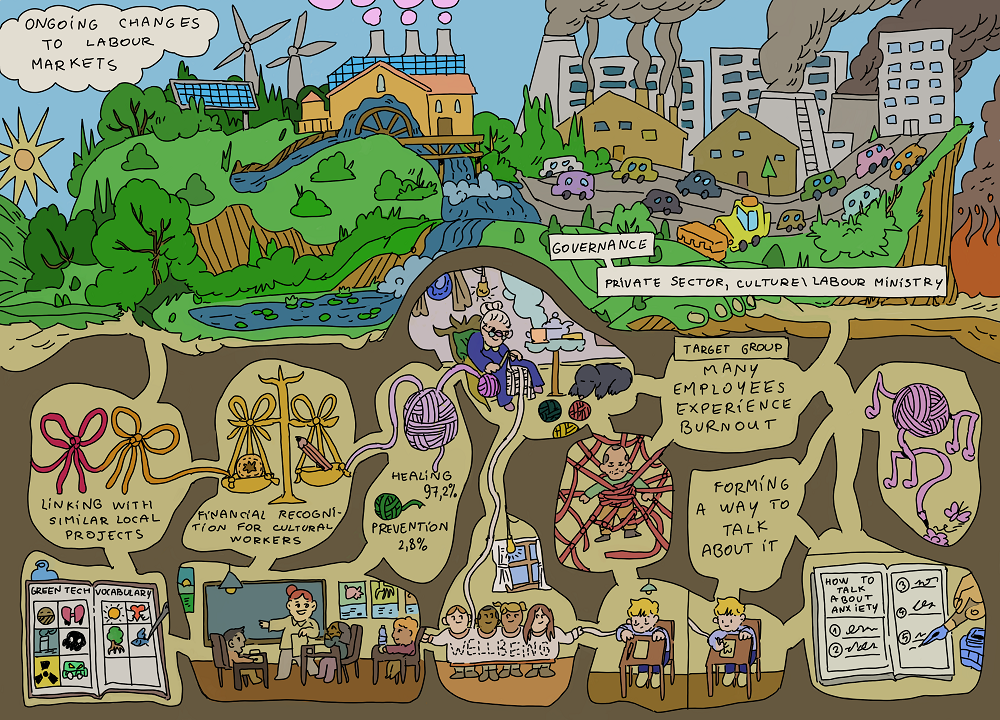
Challenge #4: Ongoing changes to labor markets, patterns of work and the economy
With the onset of automation, we might see an increase in flexibility in working patterns. However, this could also mean that the boundaries will blur and people might be required to work longer hours. This will have a significant impact on employees' lives and could lead to burnout if steps are not taken to combat it.
The transition to the green economy will require changes towards different ways of living. Cultural activities can help reduce stress and increase motivation, energy and job satisfaction by providing a creative outlet for those who participate.
One of the review's suggested solutions to this challenge is addressing it by promoting cultural activities and making them available through education, training, in the workplace, during rehabilitation and in other appropriate settings.
In the ideathon, participants reflected that a Chief Creative/Art Officer in every organisation might be an innovative metier to help workplaces with implementing health and well-being benefits using culture.
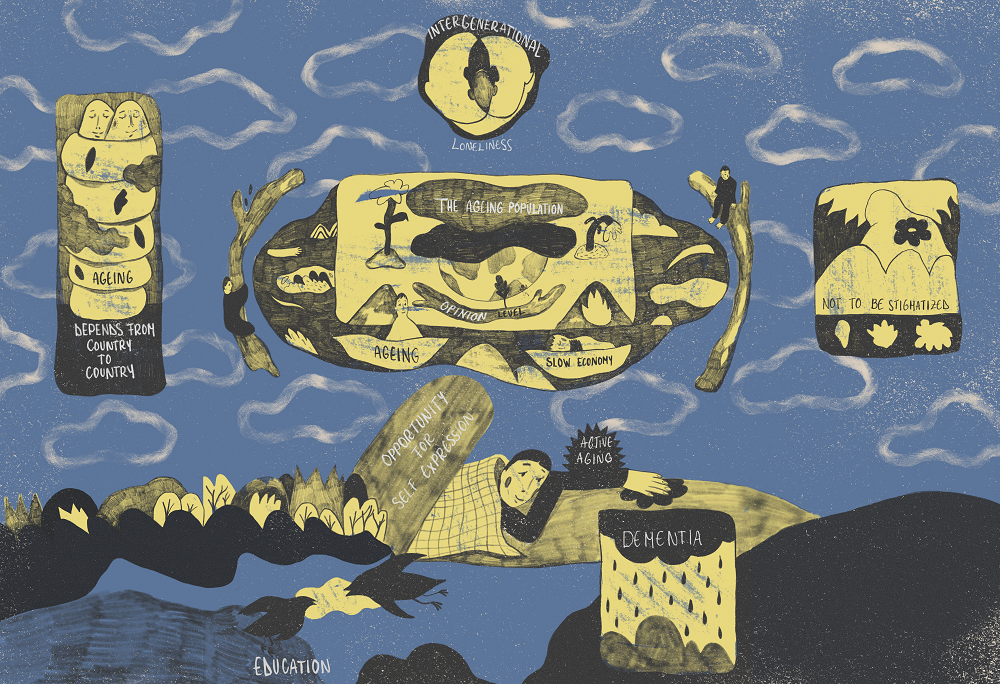
Challenge #5: An aging population
As the world's population ages, it is becoming increasingly important that we promote healthy aging in order to keep our workforce robust, our economy growing, and our society vibrant.
Elderly people who are isolated and lonely have a 50 % greater risk of dying earlier than those who are connected; they also have higher rates of stress, anxiety, depression, and cognitive decline. Isolation also increases the risk of dementia by 64 %.
Studies have proven that both receptive and active forms of cultural participation are successful in increasing social engagement and reducing isolation and loneliness among elderly people.
One of solutions proposed in the report is addressing the challenge by promoting cultural activities tailored to this specific age group, making them available in care and community settings, and supporting cultural venues such as museums, libraries, and art centers to programme dedicated activities involving the active engagement of elderly people.
In the ideathon, participants reflected on a worthy society-wide investment it would be creating positions for culture&health workers that would connect older generations to cultural organisations and institutions.
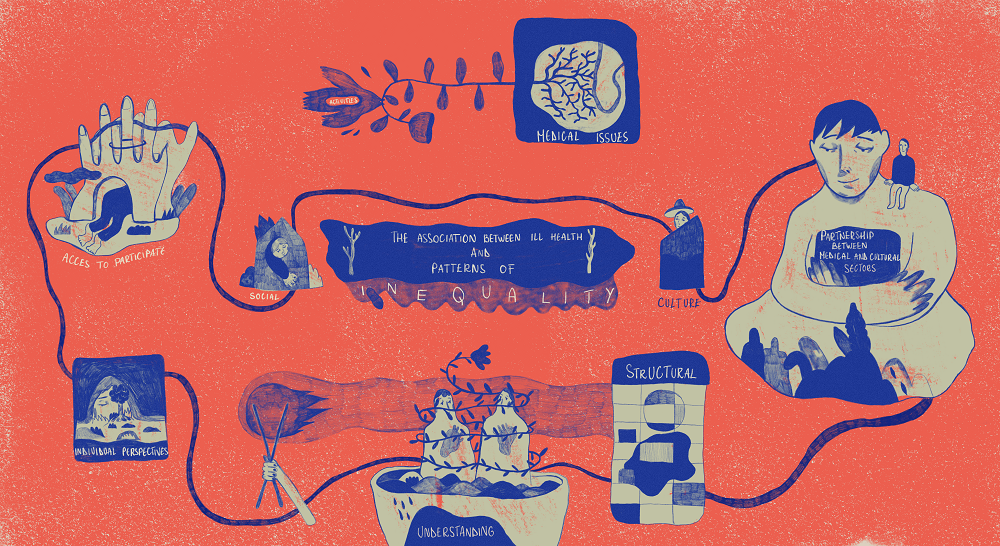
Challenge #6: The association between ill health and patterns of inequality
The WHO has identified five main factors that contribute to 90% of health inequalities. They are: the quality of healthcare; financial insecurity; poor quality housing and neighborhood environment; social exclusion; and the lack of decent work and poor working conditions.
Research has shown that cultural participation can help reduce some of these factors—for example, it has been found to increase knowledge and awareness of various health conditions among underserved communities, as well as provide support networks for disadvantaged individuals suffering from illness. Moreover, social inclusion is facilitated by active participation in art activities.
The report suggests that one way this challenge could be addressed across the EU with dedicated research and development targeting the links between ill health, patterns of inequality and cultural interventions. These efforts could be led by a dedicated team—e.g., the research and policy staff of a Centre for European Culture, Health and Wellbeing.
The ideathon participants suggested including cultural measures within the structural funds and means to measure the structural inequities.
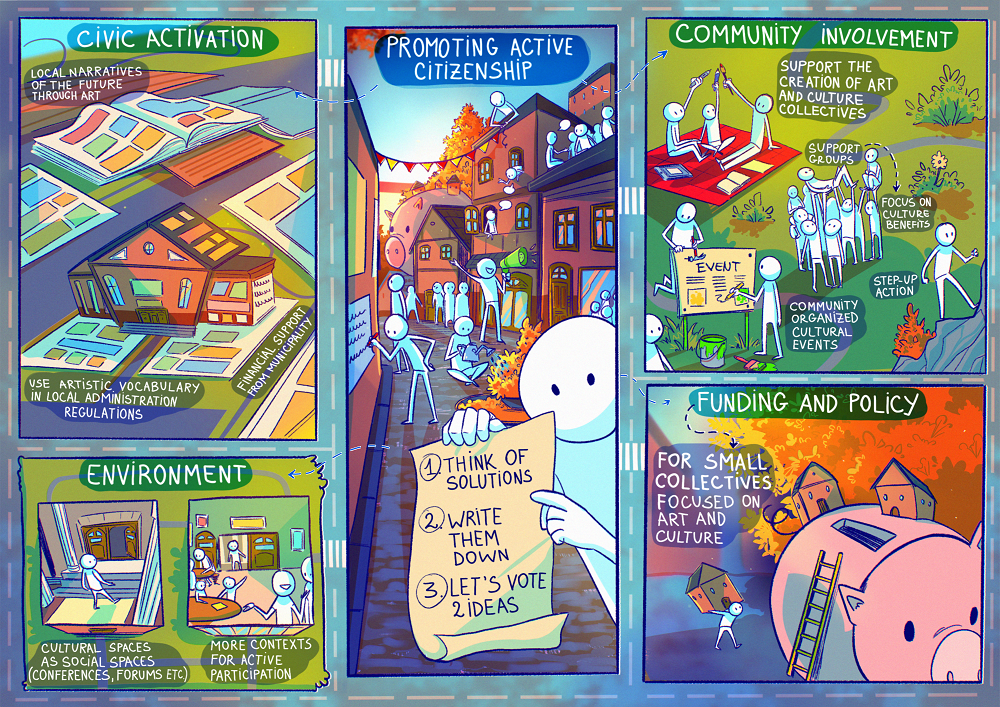
Challenge #7: Promoting active citizenship
As we continue to face the consequences of a changing world, it is important to consider how social and political polarisation, apathy and disengagement are affecting our ability to adapt as a society. We cannot afford to become isolated in our own homes, or even in our own political bubbles.
In the midst of COVID-19, many people were left feeling helpless as they watched their lives change drastically. But this was not always the case. In fact, some people took these changes as an opportunity to engage in creative activities that allowed them to develop innovative strategies for dealing with the challenges and uncertainties that arose during lockdown.
We need to promote participatory arts projects and other cultural activities tailored to promote active citizenship if we want our society to thrive in this age of uncertainty.
The ideathon team who discussed this challenge emphasised that in this context there is a strong need to promote the idea that cultural spaces are social spaces.
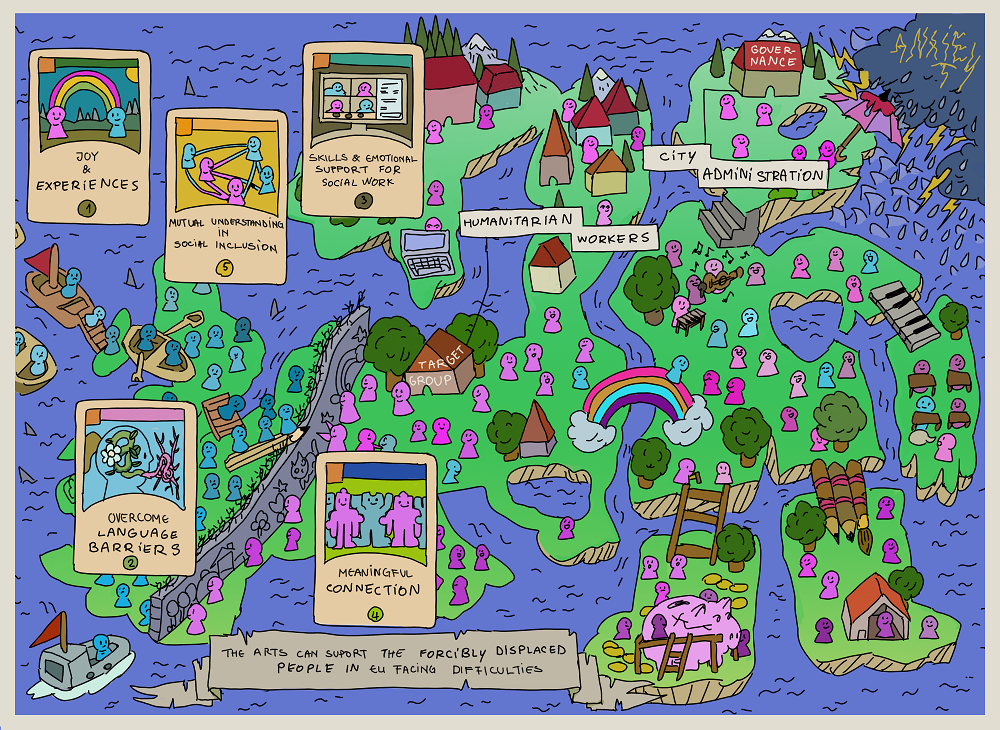
Challenge #8: Difficulties faced by forcibly displaced people in the EU
Displaced people experience significant loss, physical hardships and other stressors that often result in psychological distress.
By promoting social inclusion, social cohesion, social acceptance and belonging, arts activities can support psychological, behavioural and community processes that are linked to improved mental well-being.
This challenge could be addressed by the recommen- dations outlined in the WHO publication titled ‘Arts and Health: Supporting the Mental Well-being of Forcibly Dis- placed People’.
During the ideathon session on this challenge, the team suggested that one way these policy recommendations could be implemented is by creating a training for cultural organisations focusing on how to host and co-create with forcibly displaced people.
Visual Interpretations of Health- and Well-being Challenges








It is clear that Culture and health activities and policies should pay attention to untapped overlaps between the culture and health sectors. Cultural activities can be incorporated into health policy in multiple ways, such as in routine medical care, as auxiliary treatment, supporting preventive action and supporting individuals’ abilities to manage their own health.There is a need for further opportunities for research, education and training, and collaboration.
What will be your first step to contribute to the #CultureForHealth paradigm?
Dive into inspiration and knowledge collected by #CultureForHealth
